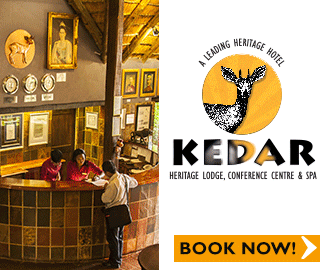
JOMO KENYATTA: The Carpenter Who Became A Renowned Pan-Africanist
WORDS: KRISTIE OMAR | 1 JUL, 2015 11:50
Previously known as Embakasi Airport, Jomo Kenyatta Airport is the aviation wonder of Kenya, which gleams from a distance commanding one’s attention. Beautifully located 15 kilometers to the southeast of the Nairobi Business District, the airport is the regional hub for East Africa, with many long-distance flights landing there to connect to countries across the region. It has become one of Africa’s main gateways for European tourists. JKIA has direct flight connections to Europe, the Middle East, Far East and the African Continent. Today, Jomo Kenyatta International Airport serves a daily average of 19,000 Passengers from Africa, Europe and Asia. The majestic wonder of the airport is just but one of its namesake’s legacies in Kenya.
The airport is named after the first Kenyan prime minister and president, Mzee Jomo Kenyatta. Unfortunately, very little is known of the early years of this man’s life. Born on October 20, 1891 at Ichaweri, Jomo Kenyatta, was also known as Johnstone Kamau Ngengi as a child. When his mother died giving birth to a boy, Kamau moved to live with his grandfather, Kungu Mangana, who was a noted medicine man in the area. Around the age of 10, suffering from a jigger infection, Kamau was taken to the Church of Scotland mission at Thogoto (about 12 miles north of Nairobi), where surgery was successfully carried out on both feet and one leg. Kamau was impressed by his first exposure to Europeans, and determined to join the mission school. He ran away from home to become a resident pupil at the mission, studying amongst other subjects, the Bible, English, mathematics, and carpentry. He paid the school fees by working as a houseboy and cook for a nearby white settler.
The year 1912 saw Jomo complete his mission school education and begins his life as a dignified man in society. But first he had to cement traditions in himself in order to gain the respect from society. This began by undergoing initiation ceremonies (including circumcision) holding his place firm in the eyes of his society. In August of 1914, Kamau was baptized at the Church of Scotland mission, initially taking the name John Peter Kamau, but swiftly changing it to Johnson Kamau. Looking to the future, he departed the mission for Nairobi to seek employment.
The Light Of Kenya
Managing to secure employment as an apprentice carpenter on a sisal farm in Thika, under the tutelage of John Cook, who had been in charge of the building program at Thogoto. Despite his seemingly beautiful progression in life, forces beyond his control began to affect him. The First World War was in progress, making Kamau a prime candidate for forced recruitment. However, Kamau evaded the forced recruitment by moving to Narok so that he could live amongst the Maasais where he found employment as a clerk for one Asian contractor. Though Kenyatta was of the Kikuyu origin, he assimilated very well with his new Maasai community. This was the time when Kamau decided to wear a traditional beaded belt ‘Kenyatta’ a Swahili word that meant ‘light of Kenya’.
In 1919, Kenyatta met his first wife Grace Wahu and they married. Church elders ordered Kenyatta to marry her after learning that Wahu was pregnant. Kenyatta had married Wahu according to Kikuyu traditions, but in 1920, European magistrate ordered him to follow Christian marriage rites. On 20th November, Peter Muigai, Kenyatta’s first son was born, and two years later Kenyatta finally married Grace Wahu in a civil ceremony. Kamau had been undertaking several jobs including being an interpreter for the High Court.
Political Career
Kenyatta began working for the Nairobi Municipal Council as a water-meter reader and store clerk, once again under John Cook who was the Water Superintendent. Meter reading helped him meet many Kenyan-Asians at their homes who would become important allies later on. This marked the start of his political career. Harry Thuku, a respected Kikuyu had formed the East African Association (EAA) the previous year. The organization had an objective of campaigning for the return of Kikuyu lands that had been taken by white settlers when Kenya became a British Crown Colony in 1920. He entered politics after taking interest in the political activities of James Beauttah and Joseph Kang'ethe the leaders of the Kikuyu Central Association (KCA). He joined KCA in 1924 and rose up the ranks of the association. Eventually he began to edit the movement's Kikuyu newspaper. By 1928 he had become the KCA's general secretary. He continued to launch a monthly Kikuyu language newspaper called Muĩgwithania (“He who brings together”) which aimed to unite all sections of the Kikuyu. The paper, supported by an Asian-owned printing press, had a mild and unassuming tone, and was tolerated by the colonial government. He also made a presentation on Kikuyu land problems before the Hilton Young Commission in Nairobi in the same year.
Worried about the future of its East African territories, the British government began toying with the idea of forming a union of Kenya, Uganda and Tanganyika. Whilst this was fully supported by white settlers in the Central Highlands, it would be disastrous to Kikuyu interests -- it was believed that the settlers would be given self-government, and that the rights of the Kikuyu would be ignored. In February 1929 Kenyatta was dispatched to London to represent the KCA in discussions with the Colonial Office, but the Secretary of State for the Colonies refused to meet him. Undeterred, Kenyatta wrote several letters to British papers, including The Times. Kenyatta returned to Kenya on 24th September 1930 and though he had failed on his mission, he had made progress in requesting for the development of independent educational institutions for Kenyans. Kenyatta returned to Britain to represent KCA’s grievances. He decided to enroll to Quaker College after the colonial office ignored his efforts. He successfully completed his studies in 1932, and in August the same year, he left for Russian to study at Moscow University after receiving an invitation from George Padmore who was a radical West Indian. In 1933, Kenyatta was forced to terminate his studies and return to Britain after Padmore had a disagreement with the Russians. He pursued his studies at the University College in London and in 1936; he managed to break through a police cordon to express his solidarity for Emperor Haile Selassie at the London Railway station.
Kenyatta published ‘Facing Mount Kenya’ using the name Jomo Kenyatta and from then henceforth people embraced Jomo Kenyatta as his name. Later in October 1945, Kenyatta joined Kwame Nkrumah to organize the fifth Pan African congress. Kenyatta returned to Kenya in 1946 and became president of KAU in June 1947 after Juntas Gichuru stepped down for him. After gaining this leadership status, Kenyatta embarked on a huge campaign to sensitize Kenyans on the importance of getting back their own land and independence from the British authorities. The British authorities began sensing Kenyatta’s popularity and banned KAU, triggering the formidable Mau Mau rebellion. Mau Mau failed to capture widespread public support, partly due to the British policy of divide and rule, and the movement remained internally divided, despite attempts to unify its various strands.
Henceforth, Kenya declared a state of emergency and Kenyatta together with other 182 African leaders was arrested. High-powered attorneys defended Kenyatta and on April 8th 1953, he was sentenced to 7 years indefinite restriction and hard labor. He was to serve his sentence in North Western Kenya, at Lokitaung. On April 14th 1959, Kenyatta completed his sentence but was restricted to the largest town in northwestern Kenya, Lordwar.
Elections were then held in May 1963, pitting Kenyatta's KANU (Kenya African National Union- which advocated for Kenya to be a unitary state) against KADU (Kenya African Democratic Union – which advocated for Kenya to be an ethnic-federal state). KANU beat KADU by winning 83 seats out of 124.
On 1 June 1963, Kenyatta became prime minister of the autonomous Kenyan government. After independence, Queen Elizabeth II remained as Head of State (after Independence, styled as Queen of Kenya), represented by a Governor-General. He consistently asked white settlers not to leave Kenya and supported reconciliation. Kenyatta retained the role of prime minister after independence was declared and jubilantly celebrated on 12 December 1963. The following year, he had Parliament amend the Constitution to make Kenya a republic. The office of prime minister was replaced by a president with wide executive and legislative powers. Elected by the National Assembly, he was head of State, head of Government and Commander-in-Chief of the armed forces. Under the provisions of the amendment, Kenyatta automatically became president.
Elected for three straight terms, Kenyatta had complete political control of his nation. His authoritarian style, characterized by patronage, favoritism, tribalism and/or nepotism drew criticism and dissent, and set a bad example followed by his successors. He had the Constitution radically amended to expand his powers, consolidating executive power. His policies are also criticized for leading to a large income and development inequality gap in the country. Development and resource allocation in the country during his reign was seen to have favored some regions of the country over others. His resettlement of many Kikuyu tribesmen in the country’s Rift Valley province is widely considered to have been done unfairly. One of his famous sayings is the following:
“When the Missionaries arrived, the Africans had the land and the Missionaries had the Bible. They taught how to pray with our eyes closed. When we opened them, they had the land and we had the Bible.”
The Death And Legacy Of A Carpenter
However, as the 1970s wore on, advancing age kept him from the day-to-day management of government affairs. He intervened only when necessary to settle disputed issues. His relative isolation resulted in increasing domination of Kenya’s affairs by well-connected Kikuyu who acquired great wealth as a result. His increasingly feeble health meant that his inner circle effectively ruled the country, and greatly enriched their own personal interests in his name. Well into his 80s, he suffered a massive heart attack. On 14 August 1978, he hosted his entire family, including his son Peter Muigai Kenyatta who flew in from Britain with his family, to a reunion in Mombasa. On 22 August 1978, President Kenyatta died in Mombasa of natural causes attributable to old age. Mzee Jomo Kenyatta was buried on 31 August 1978 in Nairobi in a state funeral at a mausoleum on Parliament grounds.
Jomo Kenyatta left quite a family-legacy as a political one. His fourth wife, the best known due to her role as First Lady, was Ngina Kenyatta (née Muhoho), also known as Mama Ngina. She often accompanied him in public and also has some streets in Nairobi and Mombasa named after her. She bore Kenyatta four children: Christine Wambui, Uhuru Muigai Kenyatta, Anna Nyokabi and Muhoho Kenyatta. Mama Ngina lives quietly as a wealthy widow, and now as President's mother, in Kenya.
Uhuru Kenyatta unsuccessfully campaigned for the Kenyan presidency as President Moi's preferred successor in 2002, but was elected Kenya's fourth President in 2013.
When the Missionaries arrived, the Africans had the land and the Missionaries had the Bible. They taught how to pray with our eyes closed. When we opened them, they had the land and we had the Bible.”
"














